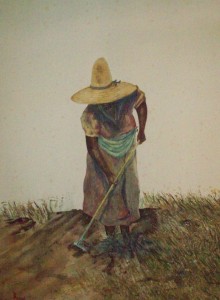
Watercolors can be divided into two kinds: transparent and opaque. The distinction is imperfect because some pigments, classed as transparent, are less transparent, that is to say more opaque, than others. What are called transparent colors are those composed of pure pigment and a little gum to make them adhere to the surface of the paper. When they are spread over the paper by means of water, the paper shows through, unless the color is applied very strongly; the greater the proportion of water used, the more transparent the color, because a larger surface of paper is visible between and through the particles of pigment.
When considering painting with watercolors, an artist must consider color, brushes, and paper:

- COLOR: All manufacturers of any standing clearly state in their catalogues the origin of each color and its degree of permanence. Certain manufacturers supply a few colors with unique attractions, other than this, the rest vary but a little. For the beginner and others who have not developed any prejudices, the best plan is to try each kind.
- BRUSHES: Inferior brushes will severely handicap a painting. If a brush is not really good, it is just BAD! As an artist, this is not the area to scrimp. Whatever the circumstances, there can be no economy in this direction. Only the best will do. A brush should be springy without being stiff, come to a point (that is if it is made to come to a point) without hesitation, and last long enough to make it far cheaper than any substitute.

- PAPER: The nature of the surface to which the color is applied is an important factor. Many artists habitually use a very small number of recognized makes and, by so doing, they limit the scope of their work and tend to stultify their abilities. The characteristics which concern the artist the most are: thickness; surface; absorbance; tone; color; and permanence. Only with an open mind and the determination to experiment widely can artists truly judge what is the best for them.
Be sure to enter the free drawing to win a beautiful art table coffee book when you sign up to receive Art Center Information’s newsletter.
